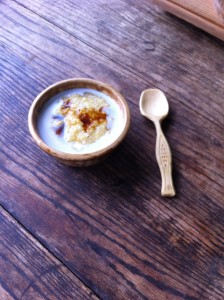BASIC SAMP, GRITS, POLENTA, HASTY PUDDING, SUPPAWN, MAMALIGA, MUSH, CORNMEAL PORRIDGE, MIELIEPAP . . .

Grits to be savored with hand carved Wooden Spoon carved by Peter Follansbee.
The two-pot-method—which was advocated by wise cooks as long as two centuries ago—may seem like a pain to set up, but you won’t mind when your lovely, creamy samp never scorches, and when cleanup is a breeze.
• 4 cups water
• 1 teaspoon salt
• 1 cup samp
• 2 tablespoons butter, optional
You need a 2-quart saucepan with a lid, and the pot you cook spaghetti in. Put the 4 cups of water in the saucepan, cover, and put over high heat to come to a boil. Meanwhile half-fill the big pot with water and see if the saucepan will ride securely in the water bath. When you have the level right, put the big pot over high heat to boil, too.
When the saucepan is boiling, toss in the salt. Gradually whisk in the samp, keeping everything moving until the mixture begins to simmer. Tum down the heat to maintain the simmer, and cook until porridge begins to thicken, stirring frequently, about 5 minutes.
Place the covered saucepan of porridge in the big water bath, and keep the bath at a low simmer. Cook thus for 40 minutes, stirring with a wooden spoon or silicone spatula every now and again. Also, add more boiling water to the big pot if needed.
The Georgia cooks I learned to cook grits from invariably added a lump of butter somewhere along in the thickening-up part, and you can too.
Taste the samp for doneness: if not perfectly softened, just cook a little longer. If tender enough for your liking yet not thick enough, cook another 10-20 minutes in the water-bath, uncovered, stirring once in a while. Also it thickens as it cools even a bit.
Serves 4.
• Use hot and fresh as a foil for a savory vegetable or meat ragout, grilled sausages or asparagus, crisply broiled fish, or fried eggs and ham.
• Pour onto a large heat-proof platter, dot with butter and chunks of feta, and pop in a bot oven or broiler for a minute or two.
• Pour into a cake pan or other form, cool, and chill thoroughly. Unmold and slice. Gently roll slices in flour and fry on both sides in a little oil until crisp outside, molten within. For a cheesy version, stir a cup of grated cheese of your choice into the hot samp before decanting into the mold.
• Serve old-Yankee-fashion, with milk and molasses, for breakfast or supper. Pour some milk in a bowl, add a jot of molasses, then ease a dollop of hasty-pudding on top. Feel sorry for poor little Lydia Jackson of Plymouth (the future Lidian—or Mrs. Ralph Waldo—Emerson). In the first years of the nineteenth century, her lither requited her and her sister to choose between milk and molasses on their hasty-pudding, because, according to the fastidious fellow, using both was “messing.”
• If you are a bread-baker, add a blob of leftover grits to your bread dough—it brings tremendous chew and moisture to your result with very little effort.
Note: If you find the Plimoth Grist Mill samp too coarse for your taste, try the above recipes with Plimoth Grist Mill cornmeal: finer texture, same great flavor. Or go halvsies; I know—it’s got be just right.






